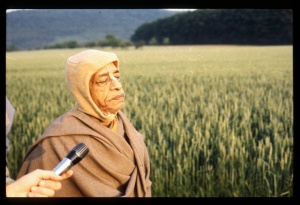CC Adi 10.13 (1975)

A.C. Bhaktivedanta Swami Prabhupada
Below is the 1996 edition text, ready to be substituted with the 1975 one using the compile form.
TEXT 13
- ācāryaratnera nāma ‘śrī-candraśekhara’—
- yāṅra ghare devī-bhāve nācilā īśvara
SYNONYMS
ācāryaratnera—of Ācāryaratna; nāma—name; śrī-candraśekhara—Śrī Candraśekhara; yāṅra—of whom; ghare—in the home; devī-bhāve—as the goddess; nācilā—danced; īśvara—Śrī Caitanya Mahāprabhu.
TRANSLATION
Ācāryaratna was also named Śrī Candraśekhara Ācārya. In a drama in his house, Lord Caitanya played the goddess of fortune.
PURPORT
Dramatic performances were enacted during the presence of Śrī Caitanya Mahāprabhu, but the players who took part in such dramas were all pure devotees; no outsiders were allowed. The members of ISKCON should follow this example. Whenever they stage dramatic performances about the lives of Śrī Caitanya Mahāprabhu or Lord Kṛṣṇa, the players must be pure devotees. Professional players and dramatic actors have no sense of devotional service, and therefore although they can perform very artistically, there is no life in such performances. Śrīla Bhaktisiddhānta Sarasvatī Ṭhākura used to refer to such an actor as yātrā-dale nārada, which means “farcical Nārada.” Sometimes an actor in a drama plays the part of Nārada Muni, although in his private life he is not at all like Nārada Muni because he is not a devotee. Such actors are not needed in dramatic performances about the lives of Śrī Caitanya Mahāprabhu and Lord Kṛṣṇa.
Śrī Caitanya Mahāprabhu used to perform dramas with Advaita Prabhu, Śrīvāsa Ṭhākura and other devotees in the house of Candraśekhara. The place where Candraśekhara’s house was situated is now known as Vrajapattana. Śrīla Bhaktisiddhānta Sarasvatī Ṭhākura established a branch of his Śrī Caitanya Maṭha at this place. When Śrī Caitanya Mahāprabhu decided to accept the renounced order of life, Candraśekhara Ācārya was informed of this by Śrī Nityānanda Prabhu, and therefore he was present when Lord Caitanya accepted sannyāsa from Keśava Bhāratī in Katwa. It is he who first spread the word in Navadvīpa of Lord Caitanya’s accepting sannyāsa. Śrī Candraśekhara Ācārya was present during many important incidents in the pastimes of Lord Caitanya Mahāprabhu. He therefore forms the second branch of the tree of Lord Caitanya.